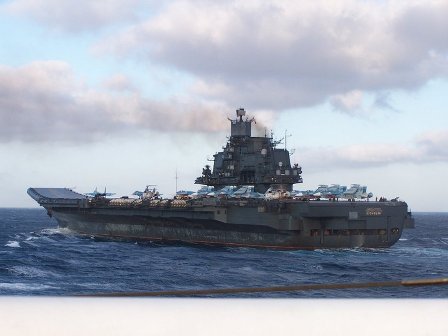Admiral Kuznetsov-class
Summary
| Origin country | 🇷🇺 Russia |
| Category | Cruiser |
| Subtype | Heavy aircraft carrying cruiser |
| Manufacturer | Nosenko shipyards |
| Year commissioned | 1991 |
| Units | 063 ADMIRAL KUZNETSOV |
| Current operators | 🇨🇳 China • 🇷🇺 Russia |
Description
The Admiral Kuznetsov, named after the famed Admiral of the Fleet of the Soviet Union, serves as the flagship of the Russian Navy. Its origins trace back to the Black Sea Shipyard within the Ukrainian Soviet Socialist Republic, where it was launched in 1985 and became fully operational in the Russian Navy in 1995. The vessel's design, classified as a heavy aircraft-carrying cruiser by Russian standards, is meant to support and defend strategic missile-carrying submarines, surface ships, and naval missile-carrying aircraft of the Russian Navy.
Unlike Western aircraft carriers which use catapults, the Kuznetsov employs a ski-jump for launching fixed-wing aircraft like the Sukhoi Su-33, designed to perform air superiority, fleet defense, air support missions, and direct fire support for amphibious assaults, reconnaissance, and naval mine placement. It also hosts Kamov Ka-27 and Ka-27S helicopters for anti-submarine warfare, search and rescue, and transport.
The Kuznetsov's operational history has been marked by its role as a central player in Russian naval strategy, providing a mobile airfield at sea capable of projecting power. In 1995-96, it embarked on a 90-day Mediterranean mission, marking 300 years of the Russian Navy, which included adapting to the Mediterranean climate and continuous flight operations. During this time, the carrier experienced a severe water shortage due to malfunctioning evaporators. Planned deployments in the early 2000s were affected by the Kursk submarine tragedy; however, the Kuznetsov later participated in various training missions and fleet exercises, including a notable deployment in 2007-08 which saw it navigating near Norwegian waters and conducting large-scale exercises in the Mediterranean.
However, its service has been marred by technical issues and accidents. Since 2018, the carrier has been undergoing repairs due to a series of unfortunate events, including a sinking drydock and a major fire, with the current projection for its return to service being sometime between 2024 and 2025.
The ship, originally commissioned for the Soviet Navy, was intended to lead the two-ship Kuznetsov class, but its sister ship was incomplete when the Soviet Union collapsed. That hull was later sold to China and became the Liaoning. Today, the Admiral Kuznetsov remains the only aircraft carrier in the Russian fleet.
Technical specifications
| Admiral Kuznetsov | |
|---|---|
| Displacement | 65000 tons |
| Range | 15000 km at 18 knots |
| Endurance | 45 days |
| Crew | 1690 members |
| Width | 72.0 m (236.2 ft) |
| Length | 305.0 m (1000.7 ft) |
| Air Park | 20 Su-33 fighters, 4 Su-25 attack jets, 6 Ka-25 / Ka-27 helicopters |
| Propulsion | 4 turboprop engines with a power of 200,000 hp - 4 propellers |
| Armament | 12 SS-N-19 + 24 SA-N-9 (192 missiles) + 8 CADS-N-1 + 6 AK-630 30 mm (VI 6) + 2 long-range RBU 12000 |
| Maximum speed | 29 knots |
Photo of Admiral Kuznetsov class
